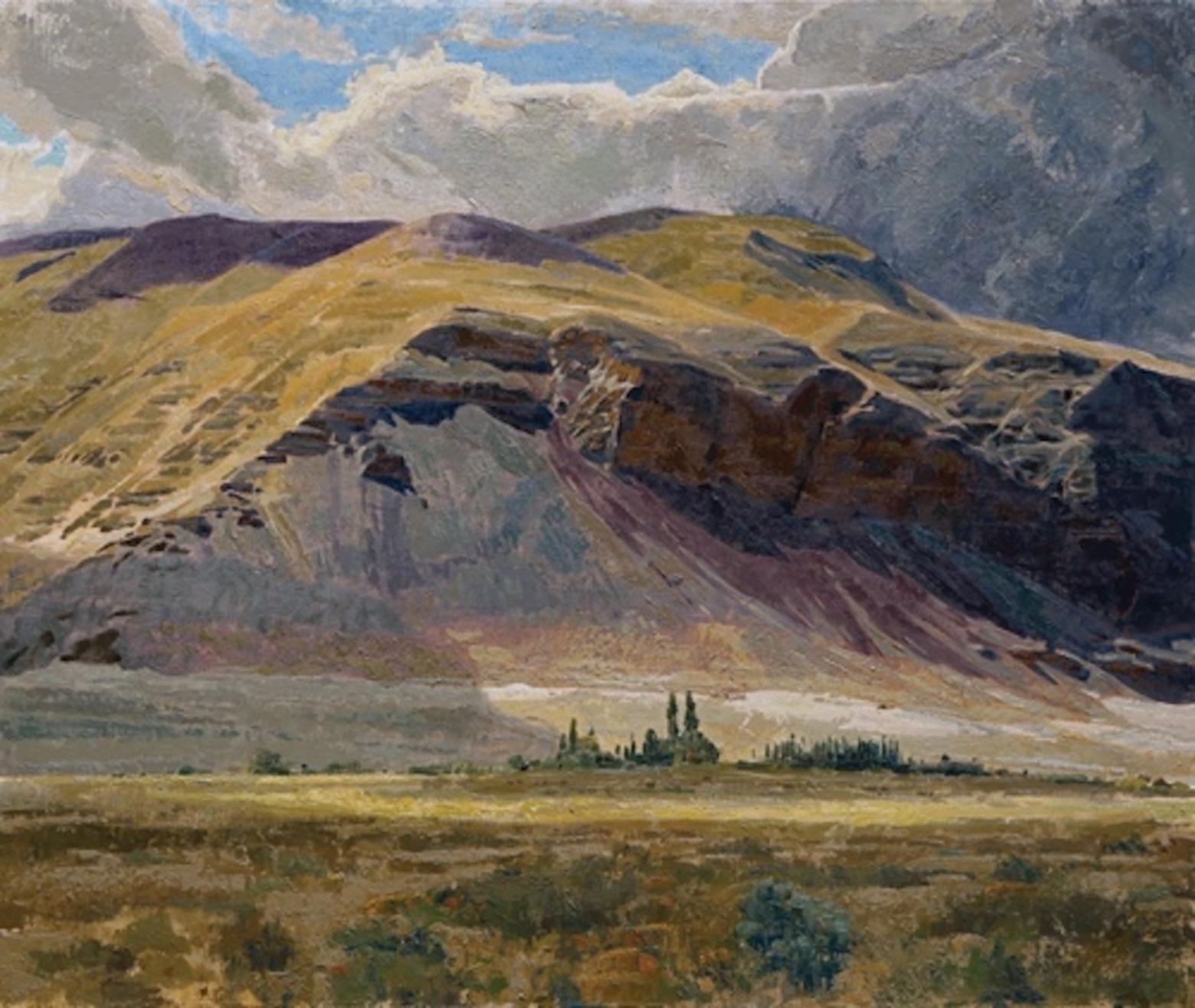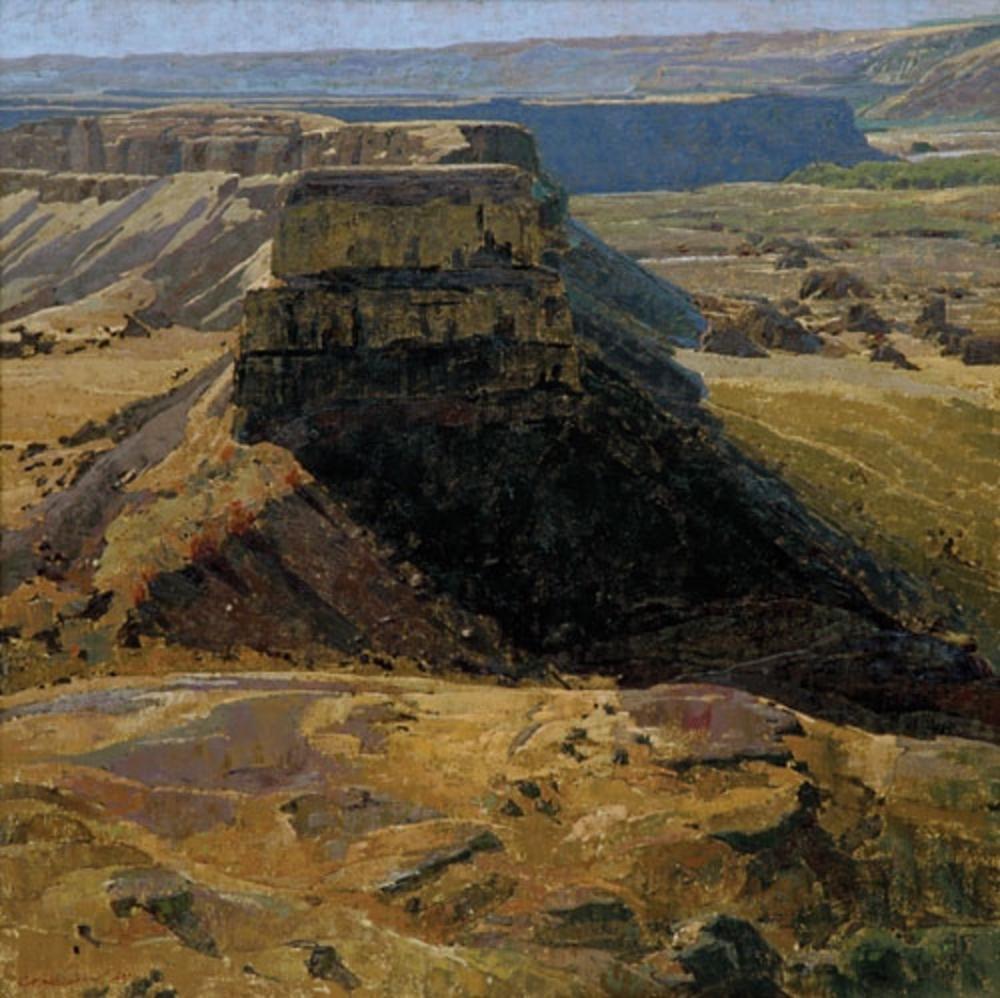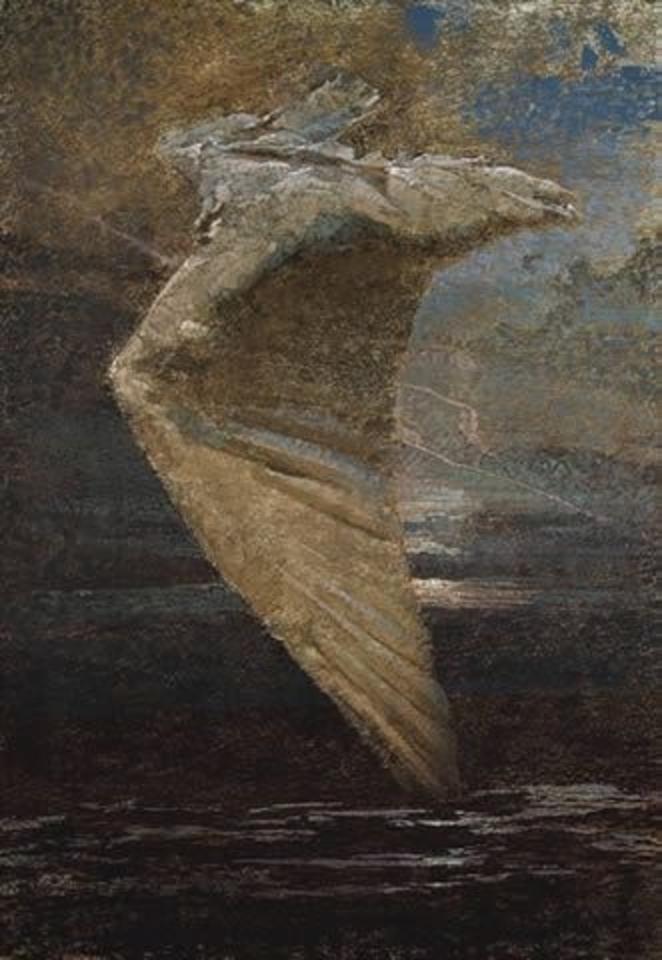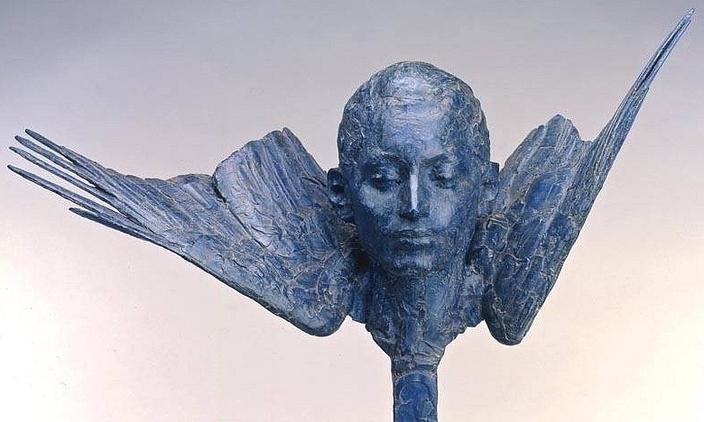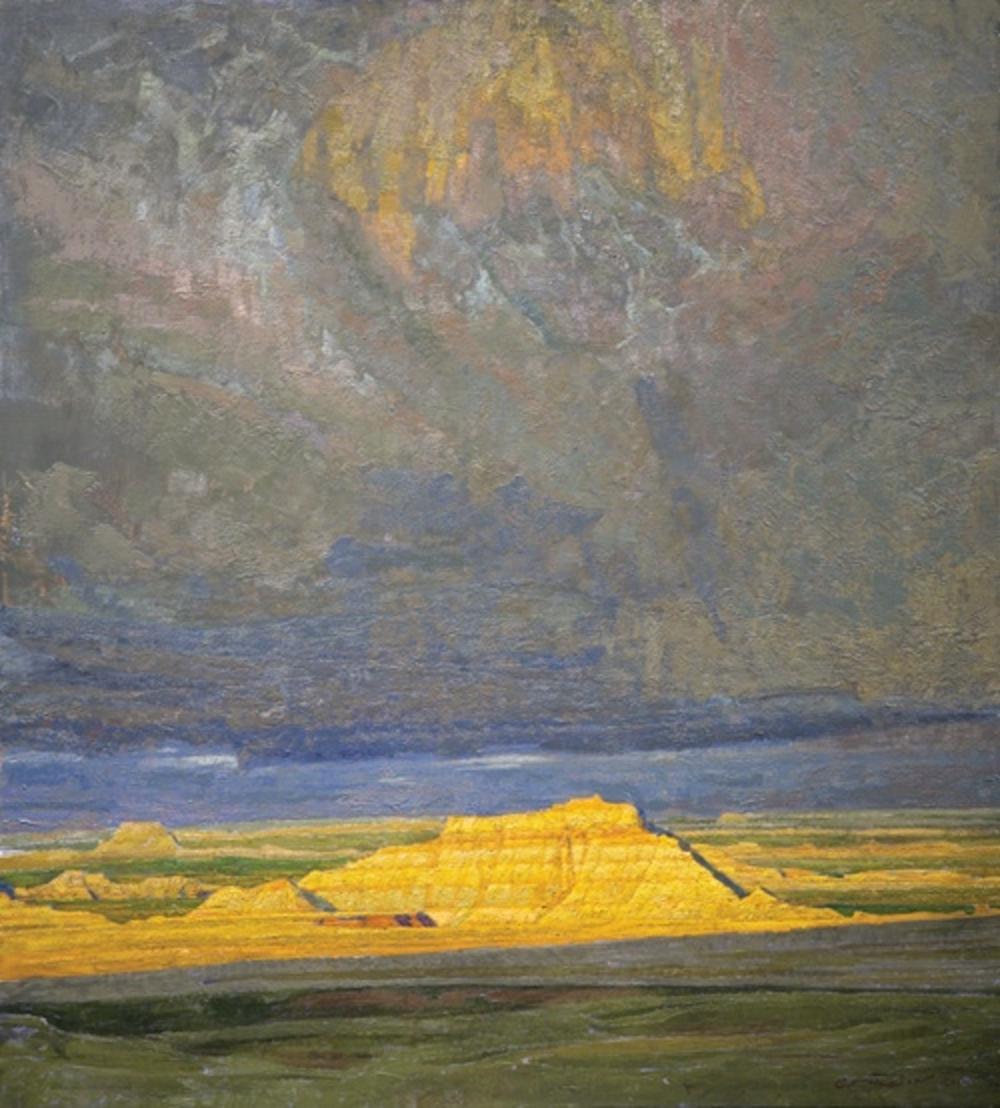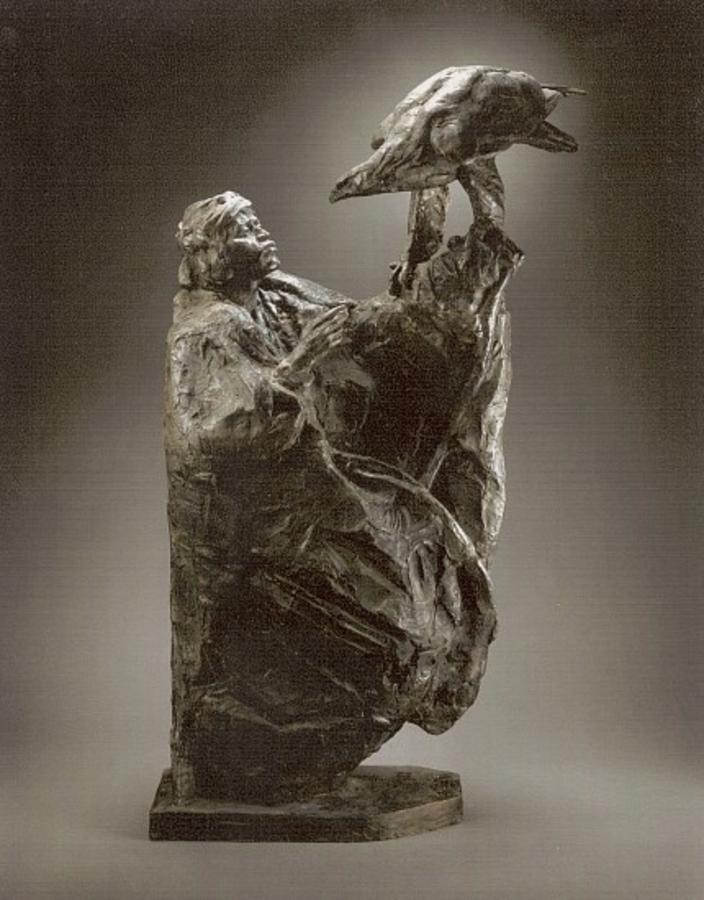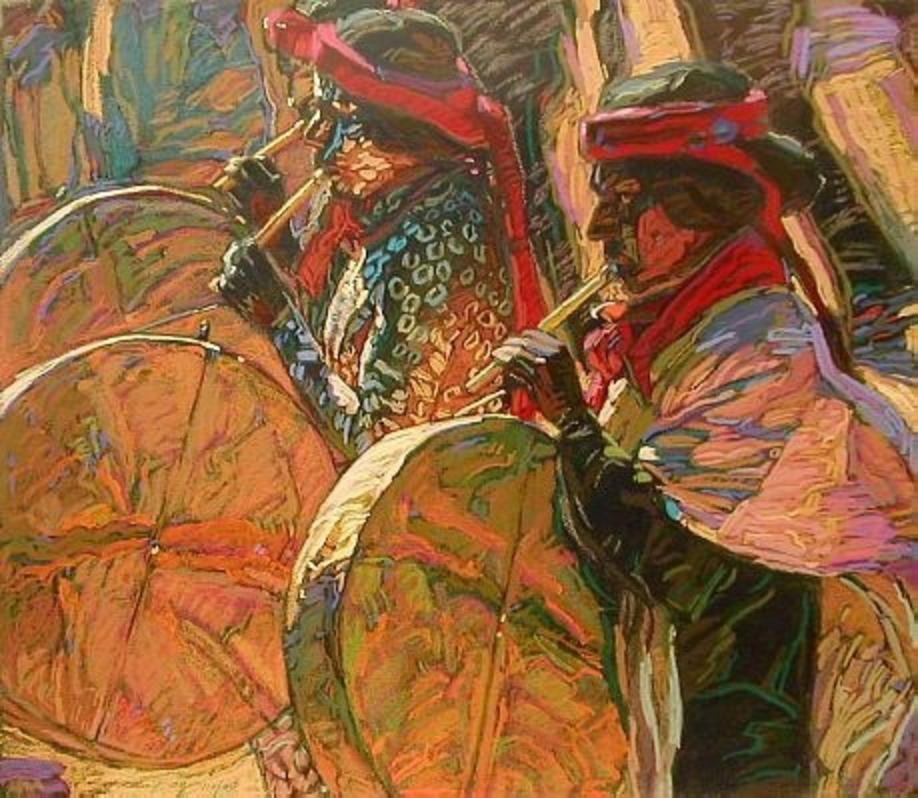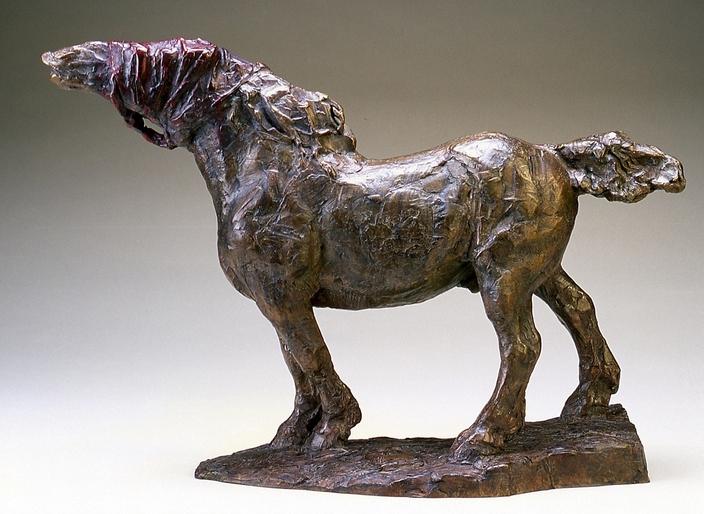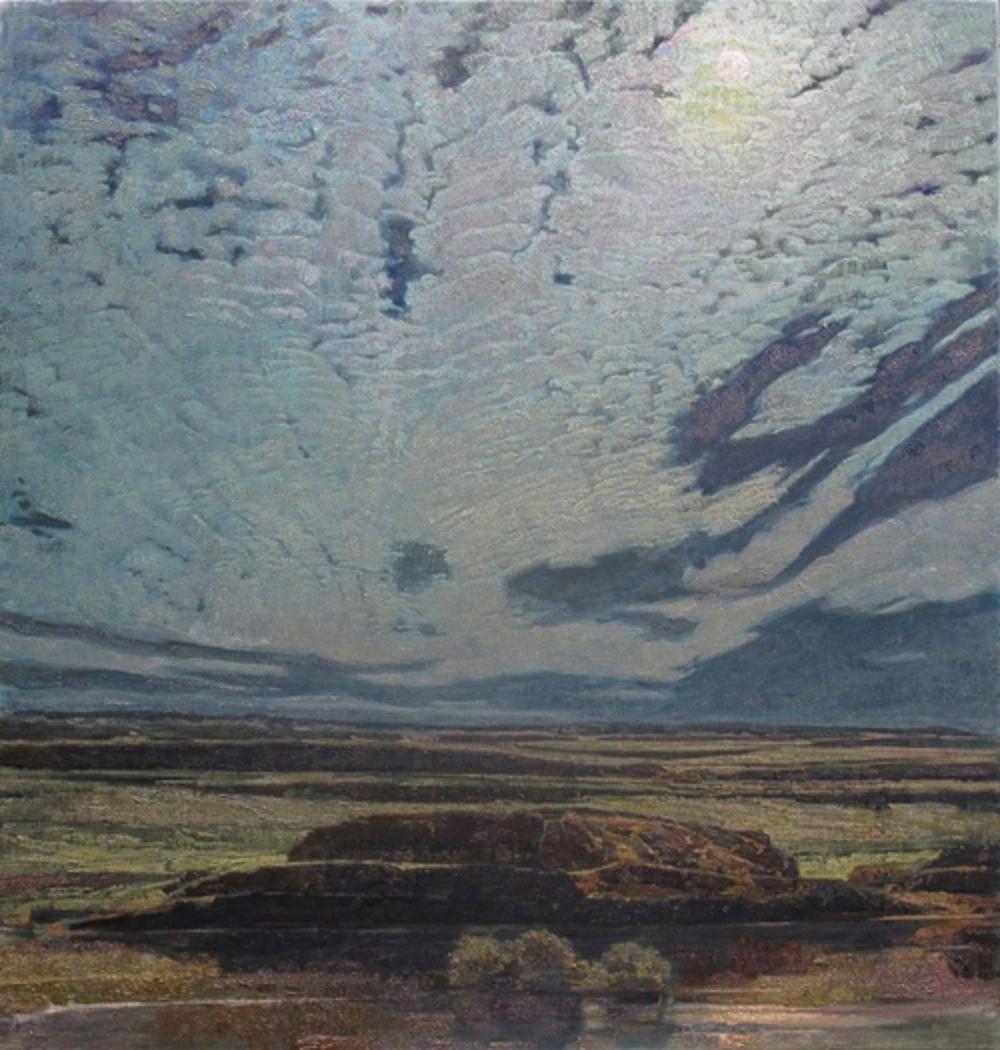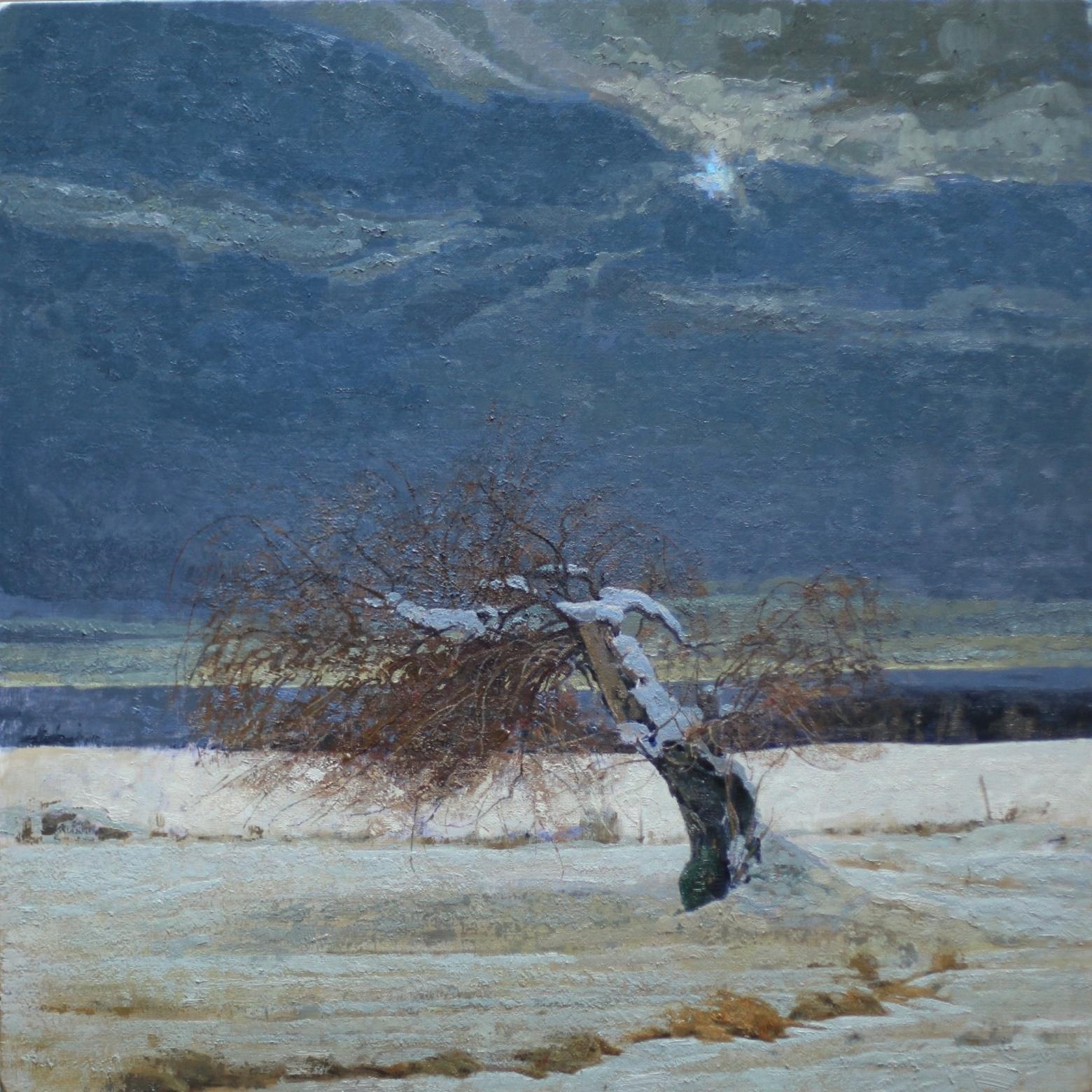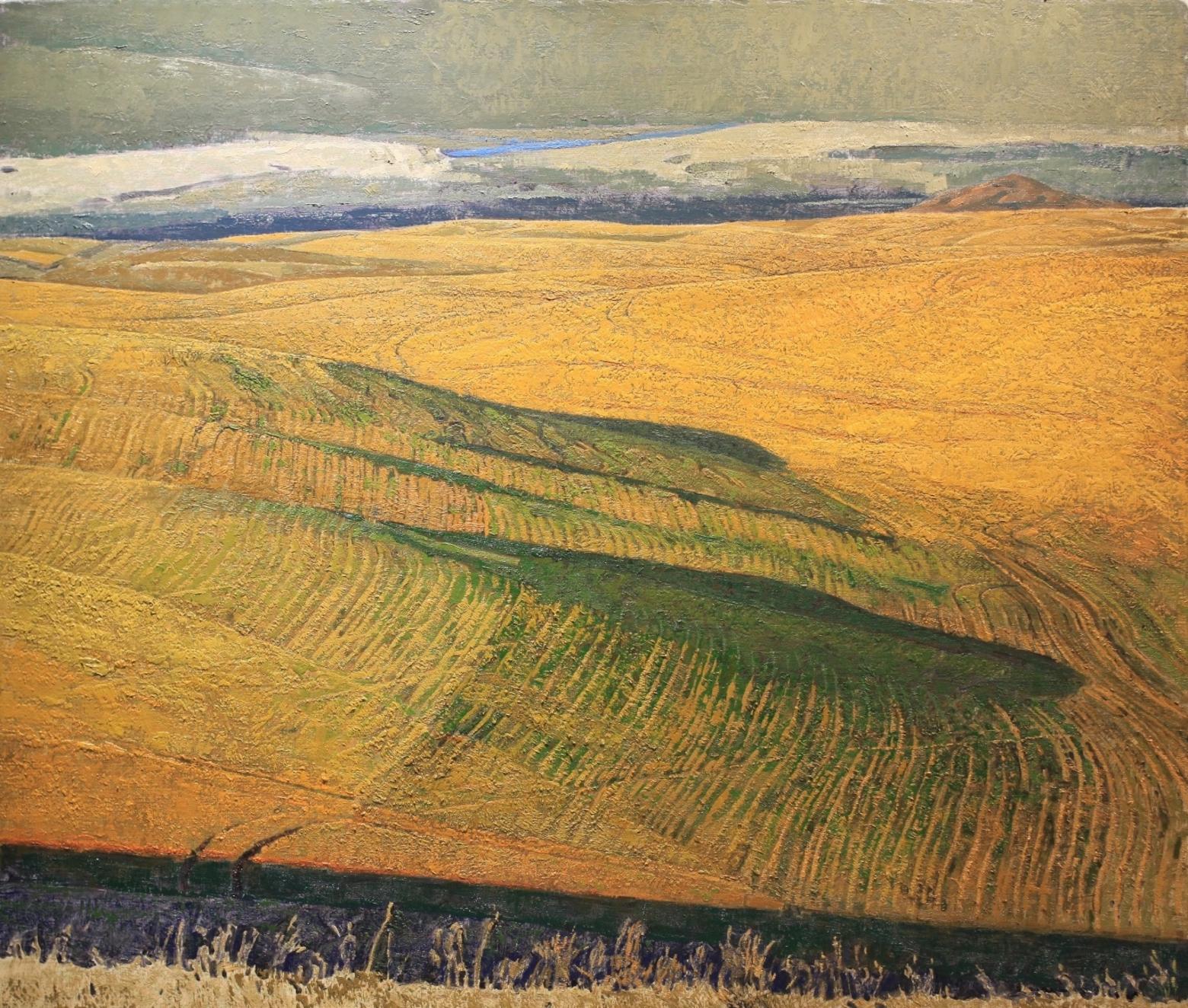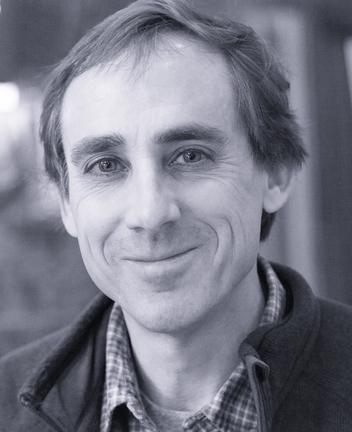Back to StoriesGeorge Carlson's Perpetual State Of Wonder
October 9, 2017
George Carlson's Perpetual State Of WonderMeet The Idaho Painter-Sculptor Who Is Considered One Of The Best Nature Artists On Earth
George Carlson doesn’t subscribe to any singular ism, osophy or
ology. If there is a word to describe the mental space where his spirit dwells,
it is in the realm of a crepuscular animal.
Carlson is willing to absorb nature during the squinting glare of broad daylight, but most of his revelations, he says, have come while
navigating auroras and eventides.
In contrast, say, to recent, nature-depraved winners of the Turner Prize in Britain, Carlson doesn’t paint scenes for which the viewer needs an
interpreter to guess what the subject or the point of the work is. He doesn't jolt the senses to get a superficial rise or create a piece because he desperately craves personal attention.
He is avant-garde in that he believes
there is radical introspection that comes from meditating on a landscape. In fact, during this age of nature-deficit disorder,
he believes that daily doses of wildness are precisely the antidote society desperately needs to counteract the numbing effects of artifice.
Carlson is widely regarded as one of the premiere representational
nature artists in the world. His interpretations of the modern American West
are said to be just as important as the gloaming romantic works by Albert
Bierstadt and Thomas Moran painted in Greater Yellowstone at the end of the 19th
century.
No one else paints like Carlson—and, in turn, he as nobody else. Being original, when so much fine art looks the same, or doesn’t look
like anything at all, is a hard thing to do. Carson, art historians say, is his generation's equivalent of Claude Monet protesting the ongoing wreckage of the Industrial Revolution.
When I think of Carlson, having written about "nature art" for 30 years, I muse how it might have been to interview one of the French Impressionists during the 19th century who were then in the vanguard of a new movement, rebelling against the staid traditions of their time, trying to advance a new visual compassionate language for conveying natural beauty. One that doesn't seek to tame or conquer or extinguish.
This day, as Carlson steps outdoors onto the stoop of a red
Swedish-style farmhouse in rural Idaho, an advancing dawn greets him. Twilight seeps forward through a sky still clutching a dissolving
half-moon. Behind, protruding softly from a stereo that’s a quarter century old,
is the sound of a piano Invention by Johann Sebastian Bach.
Out in the tree shadows, dulcet ambient birdsong amps up slowly to
mezzo-forte. From the hilly backwoods, silhouettes of deer, closer and pensive,
have just emerged; and farther, an elk mother. She and her twin yearlings
extend his sightline to middle ground.
The wapiti seem unbothered by the classical music soundtrack yet
they hold cautious in profile, well aware, no doubt, as Carlson is, of mountain
lion and bear presence. The cryptic big cats and bruins may not be far away,
though for now, are unseen. Carlson whispers that he has examined their fresh
scat on prowls through his 55-acre woods, finding mammal hair in the spoor.
He likes having them in the neighborhood, he says. He refuses to
see nature as an “other” separate from us. With the Bach piece picking up
momentum, it catches Carlson’s mood like wind in a sail, the vibe spilling out
toward a more distant horizon that hangs over a lake and evergreens crowding a
river. Adorning the edge of his property rises an old telephone pole and
platform that he erected. Now it has an osprey nest perched on top.
The cryptic big cats and bruins may not be far away, though for now, are unseen. Carlson whispers that he has examined their fresh scat on prowls through his 55-acre woods, finding mammal hair in the spoor.
Carlson removes a pad of paper from his shirt pocket, as is his
routine, and starts jotting down notes in pencil, trying to distill moments
that are evanescent. His cultivated yard, accented with splotches of blossoming
lavender becoming tinged with the first rays of sun, is edged by wildness;
tranquility is charged with expectation, just like every one of his paintings.
He is concerned about the direction of the world. Society needs to
turn its gadgets off, slow down its high-adrenalin pace to walking speed, and
encourage kids to maybe skip a few sports practices, instead getting outside in
the woods where they can sit and tune their ears to what they’re not hearing.
Do nothing, but look. In that glimpse, Carlson says, you will find everything
of meaning that you will ever need to know about the preciousness of existence.
Each of us can do it before our stardust flesh returns back to the ground.
° ° °
Less than a decade ago, at age 68, Carlson made a late return to
his original muse—painting—30 years after he had become sidetracked by
something else: a career in figurative sculpture that brought him acclaim. Carlson’s
foray into three dimensions was never thought then, at least in the beginning, as being anything more than a diversion and he never believed it would last as long
as it did.
During this “detour”, as he calls it, Carlson was honored with a
one-man show at the Smithsonian’s National Museum of Natural History and won
the prestigious Prix de West medal for a bronze, “Courtship Flight”, in 1975. His
sculpture is in the permanent collections of the Denver Art Museum, the Whitney
Gallery at the Buffalo Bill Historical Center in Cody, the Autry Museum of the
American West in Los Angeles, the National Cowboy & Western Heritage Center
in Oklahoma City, the Eiteljorg Museum of American Indians and Western Art in
Indianapolis, and the Thomas Gilcrease in Tulsa.
By any assessment, it’s a resume that already gives him a
place in art history, yet it was the result of his next move that has
earned Carlson rarefied reverence in the eyes of his peers. In 2011, he became the only artist ever to earn a Prix
de West medal in a second medium, awarded for a painting titled
“Umatilla Rock” set in a landscape almost no one has ever heard of outside the
region. The Channeled Scablands in eastern Washington were created when a
Pleistocene ice dam holding back ancient Lake Missoula burst, sending a cataclysmic
flood hurtling westward across the Columbia River plateau, leaving behind stark
and surreal landforms.
Ask anyone and they’ll tell you that Carlson’s paintings and
sculptures have a penetrating weight that cannot be measured on a scale.
“I have a strong belief in the mystical qualities of life. I know it’s unscientific and doesn’t have a thing to do with logic. But there are a lot of things that escape explanation. Those are the realms where my artistic explorations take me." —George Carlson
“I have a strong belief in the mystical qualities of life. I know
it’s unscientific and doesn’t have a thing to do with logic. But there are a
lot of things that escape explanation. Those are the realms where my artistic
explorations take me,” he said, sharing the observation as we hiked through the
forested property where he has spent three decades carving a circular path a
few miles long, mostly with a hand saw.
Maybe it’s an apt metaphor. Although Carlson finds himself at the
forefront of a new movement that is challenging the very foundation of “Western
art”, which is struggling to maintain currency with younger generations, he refuses
to think of himself as an insurgent.
“I’m content with just trying to enjoy the grand play, the big
magic show that’s going on around us all the time,” he says. “Instead of putting nature at arm’s length
distance, we need to let her back into our lives. Most of the people on Earth
dwell in some kind of blight. In places where nature is being destroyed there
is no hope.”
Unabashedly and making no apologies, Carlson has long been an
environmentalist. His activism, his way of protesting the loss of wild
ecosystems, is expressed through the lexicon of his edifying aesthetic.
° ° °
Before art historian Anne Morand passed away in 2013, she and I had
a habit of visiting regularly. Morand held down senior curatorial positions at
the Gilcrease, the National Cowboy & Western Heritage Museum which hosts
Prix de West, and the C.M. Russell Museum in Great Falls, Montana.
One day I asked her: what recent work by which living artist most
excites you? Without pause, she invoked Carlson, pointing to a then-new
acquisition made by the National Museum of Wildlife Art titled “Passage At
Dusk,” a portrayal of a giant avian wing—an allegorical reflection on
mortality, reminiscent of the angelic depictions by painter and naturalist
Abbott Handerson Thayer (1849-1921). Carlson, too, identifies as an
artist-naturalist—albeit one informed by the ecological age— and his painting
was a tribute to his late friend, the heralded wildlife painter Bob Kuhn
(1920-2007).
Carlson is not a conventional religious man but he does see
divinity—a supreme spiritual order of the cosmos—reflected in earthly phenomena.
“George, in my opinion, is the most talented interpreter of the
natural contemporary West but I don’t consider him a ‘Western artist’, at least
not in the way its subject matter has become so tightly delineated,” Morand
said. “When George took up painting
again full time, he gave up the stature he possessed as a sculptor and kind of
blew people away because he seemed to be coming at it out of nowhere. It took courage. But it revealed what really
resides inside of him. He’s one of those
rare artists who has the creative dexterity to work ingeniously across mediums.
For that, I consider him an American treasure.”
Just as Monet and colleagues became reference points for the advent
of French Impressionism, breaking with the rules of rigid tradition, Morand
credited Carlson with courting the archetypal intensity of landscapes, and
venerating them, rather than merely painting pretty pictures.
Carlson is a living elusive enigma whom contemporaries discuss with
uncommon praise. He is the artist’s artist, a neo-Luddite throwback who has
never used a computer or cell phone yet an iconoclast that youngsters strive to
emulate; he’s a painter’s painter after being a sculptor’s sculptor; a serious,
bookish, curious, intense, slightly curmudgeonly hermit finely attuned to a
higher wavelength.
He and his wife, Pam, make regular trips to the Greater Yellowstone
Ecosystem from their home near Harrison, Idaho but Carlson is averse to
painting the national parks, especially the Tetons. While many painters focus
on portraying iconic, easily recognizable picture-postcard vistas because they
yields sales at galleries, Carlson’s travels off the beaten path have risked
venturing into obscurity but it is precisely this that has made his work high in
demand.
In art, Carlson loathes nothing more than what he calls the
shameless manipulation of a viewer’s mood using cheap visual sentimentality and
subjectable nostalgia. It is especially
rife in Western art with depictions of cowboys and Indians, and it is what’s
responsible for Western art being written off as passé and redundant, he says.
This autumn, Carlson is in an eight-artist exhibition at the
Woolaroc Museum in Bartlesville, Oklahoma called “Best of the Best” that also
features works by T. Allen Lawson, Bill Anton, Tim Cherry, Len Chmiel, Steve
Kestrel, Dean Mitchell and Andrew Peters.
Each are westerners in their prime.
Lawson, the American realist who divides his time between his
hometown of Sheridan, Wyoming and Rockport, Maine, won the Prix de West grand
prize in 2017. A generation apart, he
regards Carlson as a mentor who, more than any other, has altered his thinking
about painting. It’s high praise, considering that Lawson has received
critiques from a distinguished group of friends and colleagues over the years,
ranging from Ned Jacob and Clyde Aspevig to Jamie Wyeth and Wyeth’s late great
father, Andrew Wyeth, the son of N.C. Wyeth.
“The secret to my friendship with George is that I’m extremely
lucky he’ll have me as an acquaintance. He is a genius,” Lawson says. “His work embodies everything that I admire.
It’s representational but it’s not. It’s simple but it’s not. It could easily
be seen as total abstraction. There is a mystery to it and at the same time it
holds a spiritual essence that forces internal reflection. Nobody that I’m
aware of in this country is on the same level as George. He stands alone.”
Carlson is concerned that the fraying of natural ecosystems is
sewing disharmony in society with cultures everywhere rapidly losing their
organic connections to terra firma. “We are forgetting that humble place in
nature, those places of quiet awe where we came from, every single one of us,”
he says. “We all came from the same place. We all have common ancestors whose
lineage grew out of the earth.”
° ° °
Carlson’s perspective, including the physical space he inhabits, is
a refuge from that. As a couple, he and Pam designed from scratch a sanctuary
on the eastern side of the Pacific Northwest rainforest tiered to total
aesthetics where the senses are piqued with nearly every sightline. Their home, (which features woodwork and other custom carpentry by carver/sculptor Steve Kestrel, also a Prix de West grand prize winner) was inspired by Swedish country architecture known to his ancestors in the old
country—an unostentatious structure, similar, in many ways to the place of one
of his heroes, Anders Zorn from the province of Dalarna.
In his voice, Carlson still has traces of a Chicago accent. Born in
Elmhurst, Illinois in 1940, not far away from the Frank Lloyd Wright home and
studio, his art education and connection to nature were nurtured early. He had
a tactile relationship with living creatures, creating his own menagerie
comprised of amphibians, insects and garter snakes.
His mother was a classical pianist who spent many weekends taking
her son to the Art Institute of Chicago. In 2015 at the Autry Museum in Los
Angeles, Carlson delivered a lecture on the impact of early art education in
his life. He cited a teacher, Glen
Messersmith, who introduced students to formalism, i.e. the elements of
aesthetics rooted in the DNA of the human psyche.
For the teenagers hearing it, Carlson says, looking back,
Messersmith was really delivering pep talks on the importance of beauty in
one’s life, establishing it as an antidote to despair and cynicism. He rails
against the idea that public schools are cutting back on funding for arts
programs, considering them a waste of time, but in fact they are fundamental in
shaping the way young people think about the world around them.
“He [Messersmith] was so full of zest and enthusiasm,” Carlson
says. “He was like the Robin Williams
character in Dead Poet’s Society. It
wasn’t about art. It was about seeing the art of life, its texture and
patterns, something that everyone can do no matter what their background is.
Whatever we were destined to become, he wanted us to continue the journey with
our eyes wide open.”
“He was like the Robin Williams character in Dead Poet’s Society. It wasn’t about art. It was about seeing the art of life, its texture and patterns, something that everyone can do no matter what their background is. Whatever we were destined to become, he wanted us to continue the journey with our eyes wide open.” —George Carlson
Carlson went on to study at the American Academy of Art and the Art
Institute in Chicago. After which, he
paid his dues as a commercial illustrator by landing a job first at Vogue Wright Studios and then he accompanied his boss, Ralph Thompson,
to Kranston Studios. Thompson not only encouraged Carlson to continue drawing
from live models but to take up sculpture as a way to better understand the
form. Today, he sees masculine and feminine qualities in landscapes, equating
nature to being the womb of humanity.
In downtown Chicago, Carlson had many discussions about art with a
colleague named Dick Faron. In his
private time, Faron was an Impressionist trying to make sense of
modernism. “He had a way of adding in
abstract qualities to his representational work and paid attention to all of
the aesthetics subtleties so that a painting could read one way when you
stepped close and say something grander when you stepped back,” Carlson says.
He adds, noting, “At the time, in those days, the high priests of
art were preaching that pure aesthetics were no longer fashionable. There was no room for beautiful brushstrokes
and beautiful representations of nature. Art was all about the pop and the
flash, the concept, the idea, not the execution. In a world of
post-expressionism, art was anything as long as it was recognizable to only a
single person—you, the creator, and no one could challenge it. It was an attitude that gave people a license
to create nothing and call it something. In sculpture, you could take a pallet
of bricks, dump them on the floor and call it a ‘profound statement of
creativity.’”
An intellectual old schooler, Faron engaged Carlson in many long
discussions. He told his young colleague
that a painter ought not to answer all of the questions a work is created to
raise in the viewer’s mind, that a great enduring painting is continuously expanding
the sense of the unknown, offering something fresh to the viewer upon every
visual interlude.
° ° °
Carlson embarked upon a period of
seeking that certainly Millennials and every generation before them who came to
the West can understand. In 1964, burned out on the stressful deadlines of
commercial illustration, he gave up his day job and headed to the Rockies,
becoming a ski bum and dishwasher for a while in Aspen, Vail and Taos. During visits to Taos Pueblo, he was awakened to the harmonization that indigenous peoples know, the holistic melding of
tradition, religion, art and spirit.
His curiosity stoked, he enrolled in the anthropology program at the
University of Arizona. Through Professor Clara Lee Tanner's insights into
various aspects of the Southwest Indian cultures. This prompted him to
pursue these cultural interests by spending time with different tribes of the
Southwest. His passion for art heightened.
He settled in Taos for about a year getting to know several
artists who eventually became lifelong friends, along with Bettina Steinke, the
great encourager. By this time Carlson was working with a number of Taos
Puebla Indians as models.
Carlson began working in sculpture to intensify his understanding of form, mainly as a tool to fortify drawing skills since sculpting is drawing in
three-dimensions, while continuing to work with the Indians of the Southwest, as
well as some of the Plains Indians. He built up a body of work.
After Carlson relocated to Denver his works, much to his surprise, found an
enthusiastic audience. Then in 1973 he heard about the Tarahumara Indians from his photographer
friend in Taos, Dick Spas, who had done extensive work in the Copper Canyon in
the State of Chihuahua in Mexico. Telling stories that fed his mind with
all kinds of imagery of a people that still lived in caves in some cases
practicing their aboriginal roots.
“I had a sense, even then, that what I was witnessing was on the
brink of vanishing forever,” he says.
“The old ways had survived but the Tarahumara were being rapidly
inundated by outside forces. They allowed me, invited me, in to help them
chronicle ceremonies so that there would always be a physical embodiment for
future generations to have as reference beyond verbal description.”
Over a period of four years consisting of six two-month stays camping in
a 8' x 10' wall tent Carlson could immerse himself into the daily, as well as
the ceremonial life of the Tarahumara people. With the help of his guide,
Mario Parra and various tribal leaders of each valley, spread out in small farm
plots, he could chronicle a beautiful culture.
Carlson says, "I wasn't interested in doing works that romanticized
their way of life. Some works showed a child with tuberculosis while
other pieces would depict their athletic prowess also how they lived in their
environment."
As a result, with being able to absorb this experience, he packed wax for
sculpture, oil and canvas, plus paper for watercolor and drawings. The
day's work would start early with several dozen Tarahumara quietly circling his
tent. Some were interested in modeling and some weren't but the end
result from each trip was about 20 to 30 sculpture studies, 15 oil studies and
many, many watercolors and drawings. When finally back home, he began working all of these
studies into final works.
It was exhilarating to receive national acclaim for the body of work,
earning him exhibitions at the Kennedy Gallery in New York and later, in 1982,
an exhibition at the Smithsonian Natural History Museum in Washington, D.C.
Carlson forged a close bond with his hosts and knew his time there
required sensitivity. He was well aware
of the Taos School artists’ interaction with Puebloans, the works by Sharp,
Coues, Dunton, Blumenschein and others. He knew there had been some tension,
accusations made by native people that some of the subjects felt exploited.
With the Tarahumara, and not wanting to compromise the dignity of the rituals
he was documenting for posterity, he subjected his works to critiques by elders
both for their veracity and their determination for whether they wanted the
scenes shared with the rest of the world.
Guiding Carlson were the words of Loredo Taft. In 1923, Taft
(1860-1946), who had studied at École
Nationale Supérieure des Beaux-Arts in Paris and later taught at the Art
Institute of Chicago, penned “The History of American Sculpture.” In that work, Taft observed that “the first
requisite of any artist is intelligence and the second sympathy; but an artist
is not compounded of these two elements alone…Taste must enter early into the
artistic composition and skill and mastery must not tarry far behind.”
Sympathy, Carlson says means speaking truth based upon respect,
a check against any compulsion one might have to exploit subject matter, and it
extends to landscapes as well as to life forms.
For Carlson, there’s a difference between being, on the one hand,
sensitive and, on the other, sentimental; the former drives a deeper
conversation within himself; the latter is about eliciting an easy and
superficial response in the viewer. He equates such sentimentality with kitschy
calendar art and refuses to go there; it’s why he savors the out of the way
places and the overlooked in nature—why his “Western art” looks nothing like
the visuals held up as its cliché.
° ° °
In Idaho, the Carlsons have courted solitude, having many visitors
but rarely going into the city. Expressions of their tranquility are gardens
planted with perennials to deliver constant blushes of color. In spring, the eruptions start in front of a
pergola not far from their rose garden on one side of their home and a
profusion of wildflowers on the other.
A short drive away, Carlson has a studio in a former church in
Harrison where trappings of his sculpting career fill the old sanctuary.
Upstairs is an impressive library with volumes on art history and works by
naturalists and philosophers. Off to one
side is Carlson’s tiny painting space, bathed in natural light that seems lit
by the stardust of an earlier era. It is here, in this humble room, that
Carlson made a move, having become tired by the laborious, hand’s-on process of
making bronzes.
Carlson admits that the Channeled Scablands appeal to him because
of their inherently sculptural quality, being forged by some of the most
powerful elemental forces. The great flood which created the scablands scoured
the earth down to its bedrock, leaving behind exposed monoliths protruding from
the undulating roll of the Palouse and its adjacent dryland desert coulees.
Carlson took notice of the landscape while making trips between his
Idaho studio and a foundry in Oregon. The scabland’s geologic origin, the path
they took, and the creatures inhabiting them, such as an abundance of raptors,
left him tantalized. He began to photograph and sketch them during road-trips.
Then, as visions of them started entering his dreams, he contemplated painting
them, but groundwork needed to be laid.
"I had made paint charts at the American Academy of Art, fifty years
earlier, only to realize they weren't of much use," Carlson says. " I reworked the charts
10 - 12 years ago to reacquaint himself with a better understanding of how to
achieve various color mixings. The charts were made by mixing each
predominate pigment in a careful way with all of the others colors of his
palette, he notes. "Each column of color was mixed with white, from dark to light,
to render out to six values. The purpose was to see what each color
combination looked like when they interacted. I started out with eleven
colors in my palette but there are times when I like to see what other colors
will do so over time I have built up quite a few charts but I use mainly the
original eleven."
Used as a reference, he is able to match any color he finds in
nature, no matter how nuanced or subtle. As Carlson notes, he’s not looking for
a literal color choice the way an angler might choose a dry fly to match an
insect hatch, but colors that authentically speak to the hum and vibrations he
feels about a place.
The Seattle stone carver Tony Angell said many were puzzled
when Carlson walked away from bronze. “He was doing these remarkable interpretations
of human and non-human forms in bronze. Every one had such gravity and placement,
like they were just getting on with what they were destined to become,” Angell
said.
It might be an interpretation of a native shaman, or light-footed
ballet dancer pirouetting in New York, or draft horses. “Whatever he chose to
interpret, it had virtuosity,” Angell noted.
“So few ever reach that place of command and originality. So I was
surprised when he unceremoniously finished that part of his career—and strived
to do the same thing with a brush. It
took cojones.”
Carlson, of course, didn’t issue a press release. He simply exhibited a painting among a
selection of his sculptures at Prix de West and it left people both stunned
and, initially, confused.
“When thinking of Carlson’s landscapes, there is no separation from
what he started doing 60 years ago, interpreting and exploring the form,”
Angell, who saw no incongruity, explained. “George continues to delve into his
own relationship with the earth. The way
he seeks to understand organic forms is no different than if he were taking on
a human or animal figure. He has this wonderful, imaginative understanding of
the cycles of nature. You see it in the texture of his painting. He takes us to
the surface and then digs into the deepest elements of what we are and what we,
as sentient beings, stand upon.”
Angell says that “in every one of his paintings, I as a sculptor
can feel my fingers tingle. I want to put my hands on them because he speaks
the tactile truth of physical contact. I don’t know how many times people can
portray a landscape but there is only one Carlson and when he does it, it is
singular, distinguished, and genuine.”
Artistic influences in Carlson’s life cover a gamut. With sculpture, he points to Degas and Rodin,
Paolo Troubetzkoy and Medardo Rosso, among others. As far as painters, there’s Emil Carlsen,
Anders Zorn, Antoni Tàpies, Antonio Mancini, Thayer, Richard Schmid and
the late Bruce Kurland. He also points to works by Lawson.
° ° °
Sue Simpson Gallagher, owner
of an eponymous gallery in Cody, Wyoming, had heard about Carlson for decades
and viewed his sculptures in museums. In
2002, she attended a Carlson one-man show of horse sculptures hosted at
Nicholas Fine Art in Billings, Montana. “Everyone
was talking about it. The show was extraordinary,” she says. “But I realized
upon seeing it that although everyone was referencing the work, they were
really talking about George as a hero, a mentor, a demigod in the world of
Western art who dared to challenge the fairly rigid definition of what it
[Western art] was.”
Carlson’s influence and his
mentoring of painters like Lawson, Simpson-Gallagher says, is not perceived as
an act of rebellion but along with others like Russell Chatham, advanced a
different way of approaching landscape in Western art.
“George is a positive,
encouraging proponent of good art and artists who are willing to embrace the
struggle and not brook shortcuts,” she explains. “He’s also a generous spirit
who values friendship, loyalty, commitment and kindness.” There’s
something else, Gallagher-Simpson adds, Carlson is a partner who treasures the
companionship of his wife more than this art.
“His respect and appreciation
for Pam make him even more lovable,” she says. “They are a terrific team.
They make each other better people. Pam is the perfect artist
helpmate. She is also grace incarnate.”
Simpson-Gallagher wasn’t
surprised by the public reception that greeted Carlson when he switched back to
two dimensions from three. “Now as I view George’s paintings I see that the
medium is not what is most important, it is the vision and its translation that
matters for him. His technical prowess is unmatched in the world of
painting today and his art spirit is unparalleled. He is able to
take a place or an idea of a place and make it sacred,” she says. “It’s what
makes the artists I see at shows standing in front of one of George’s paintings
ask each other, ‘How do you think he does it?”
Carlson never truly gave up painting. During the sculpting years he
would switch back and forth doing sculptures and pastels. He just created works that no
one ever saw. “When I was immersed in
doing monuments, I could work intensely for five hours and then get exhausted,
so to unwind, to loosen up again, I would sit down and do pastels,” he says.
To create a richness in the pastels Carlson would build up layer upon
layer of pastel, in some cases juxtaposing different colors to harmonize with
proceeding layers ... colors that would create vibration ... sometimes with
complimentary colors and at other times with other combinations, working
towards the final feeling of vitality of color and texture. "I
wanted to create a different surface, like the tapestry of a rug where you can
feel the weave underneath."
He pursues the same with oil. Scuffing his surfaces, applying paint
then sanding it back, sometimes relentlessly over and over again until he
achieves the coarseness of earth he’s portraying, Carlson acknowledges he wants
his works to exude tactility, to have the sensation of a physical encounter
reverberate at the gut level.
“I obviously like
texture. I like working with malleable
materials,” he says, noting that he feels kinship with the anonymous Cro-Magnon
artists who painted in the caves of Lascaux, grounding their own pigments and
applying paint with their hands.
“They’ve been on the walls for millennia and they still exude vitality.
There was no artificial distancing between what they experienced in their world
and their expression of it. It still reads fresh.”
"Classical music moves me into a subconscious state when I forget about the painting and am thinking about what I’m hearing, how to translate it into something of substance for the other senses."
Many of Carlson’s paintings are extensions of sonic cues adding to
the information he chronicles in his field notes. “Classical music moves me into a
subconscious state when I forget about the painting and am thinking about what
I’m hearing, how to translate it into something of substance for the other
senses. It is the language I equate between the visual and the
audio. It's my touchstone."
When Bach plays major and minor keys, Carlson
explains, he is essentially playing cools and darks, to put it in the parlance
of painting. “To me, music and painting are interchangeable with the use of
language to describe what is happening in a piece.”
Color is a note. Modulation and variation are
plays in value and tone; design speaks to rhythm; harmony stokes the deepest
depth of feeling. Just as we listeners know it when we hear it in a musical
composition, he says the eye, brain and heart create a synchronicity that is
ineffable. “We exist because of our
sensual response to nature; the world we’ve created is shaped by it and I
believe that our disharmony is a result of not listening to what’s happening
around us. Or, to put it another way, we’ve forgetting, because we’re becoming
so anesthetized by gadgetry and virtual reality, how to let awe seep into our
souls.”
Lawson shares an anecdote. “I called up George and told him I was
really struggling. Then I heard a little sigh on the other end followed by this
response, ‘It sounds to me, Tim, like you are exactly where you need to be.
Everything that I have ever found worthwhile takes place within the tension of
struggle.’ To hear it coming from him
meant a great deal. I took it to mean
that unless you are constantly pressing the limits of your perception, you’re
not going in the right direction.”
° ° °
Many of Carlson’s works are massive, typically within the dimension
of 40 X 40. He only creates a handful a
year. Carlson might spend weeks trekking
through a place. It’s not until he feels the energy of the earth coming up out
of the ground pulsing through the soles of his hiking boots that he considers
making a painting.
With “Secluded Pond,” a piece featured in the Woolaroc show, a
heron prepares for touchdown on a pond, patterned with dollar lily pads and the
green forest in the background reflected in dark water at the bottom of the
scene.
In "Dragon Sky", Carlson explores the sensations emanating from an
evening cloud formation drifting over a series of tarns known as the Sun Lakes.
The landscape, to him, read as prehistoric. Dragon Sky had the look of a mythological dragon
swooping down on the horizon.
And then there’s a work like "Autumn Notes", Carlson’s paean to the
hidden beauty of the overlooked. For years, Carlson had tromped down his trail.
“Then one day I happened to stop and looked at these small hemlocks kind of
concealed by the bigger trees.” But as he stepped closer he noticed the
patterns of greenish moss and a forest floor glowing with reddish pine needles
that turned purple in the late afternoon light.
While striving to convey "the rhythms, hum and vibrations of the earth”, Carlson paradoxically eschews employing loud primary colors, believing it better to be underactive with palette than resorting to blinding colors which to him equates to dissonance.
“I fell in love with these hemlocks doing their own little delicate
dance. It started another aesthetic conversation inside me,” he says,
explaining that the painting was his way of expressing the traditional Japanese
aesthetic known as Wabi-sabi. It is not
based on an idealized romantic notion of nature but of embracing transience and
imperfection. It is a counterpoint to
the big dramatic views championed by adherents of the Hudson River School and
manifested in the works of Bierstadt, Moran and others.
While striving to convey “the rhythms, hum and vibrations of the
earth”, he paradoxically eschews employing loud primary colors, believing it
better to be underactive with palette than resorting to blinding colors which
to Carlson equate to dissonance. Taste in a painting has to do not with
indulgence but with restraint, he says.
Not long ago, George and Pam were having dinner with another
couple. The husband was a historian and
magician and his wife a musical entertainer. “They interact with the public and they noticed how society is
overwhelmed with sensory overload and a baseness that is pulling human dignity
down. It’s like we suffer from attention deficit disorder as a culture.
Technology is de-sensitizing us rather than making us more receptive and
aware. We hear all this talk about
spirituality but we’re unable to come together and meditate on anything deep,”
Carlson says.
“When I listen to Bach, I try to become totally empty, to void
myself of the extraneous, and let each note come through, like pure drops of
water hitting a plant in the sunlight," he adds. "Every note reflects the world. Only when
the outside noise goes quiet and I surrender myself to hearing what the music
is telling me, can I even attempt to achieve a similar kind of harmony
visually.”
While translating sonic cues into his own repertoire, Carlson is
thinking of several paintings on his studio easel. He is too modest to draw a
direct comparison between himself and the composer, of course, though if an
outsider delves deeper, pressing Carlson, one can see the same kind of
structure Bach mastered in classical structure informing his approach to visual
composition.
What invigorates Carlson is “art that offers a hint of something
bigger and deeper out there. I believe
there’s sentience, a way of being that exists between not just humans and other
higher animals but it’s there in forests and plants in moving water, at the
microbial level, in the soil, and mountains and breeze. We’re here for only a
moment in time; what a waste to let it pass unnoticed.”
Every day Carlson makes a trek into his backwoods. It’s in those
hills where he methodically, over the last 30 years, carved a looping trail by
hand over the course of several miles.
On this morning he’s meeting with a local logger. He’ll tell the sawyer to thin out aspects of
the overgrown canopy, not to topple old trees for merchantable timber, but to
make the diverse coniferous and deciduous glens more resilient and
healthier. He is thinking about how his
personal sanctuary will be years from now, after he is gone.
Reflecting on a morning when he watched the deer and elk in his
yard, following an evening when he discovered mountain lion spoor on his hiking
trail, he says, “Isn’t it revealing, except perhaps when there’s a predator and
prey encounter, how nature never seems to be in a hurry? Her beauty is prolific
but not accidental. It’s the culmination
of so many miraculous events intertwined on this planet, that we take so for
granted. In the entire known cosmos, the forces of life have aligned here and
yet so many of us are caught up chasing things that don’t really matter.”
What is the point of his own painting? “If you as an artist seek to provide all of
the answers, there is no need for viewer participation and reflection,” Carlson
says. “All I can try to do is bear witness. I don’t like to invoke a word like 'spiritual' because I think it is overused and pretentious. But when I get into
the zone of concentration, it is almost like I’m entering a sacred space and
for me, I guess, it’s the closest thing I can do to dwell in a prayer.”
EDITOR'S NOTE: Portions of this story appeared originally in a piece penned for Western Art & Architecture magazine. Enjoy Mountain Journal's "Short Cut" video featuring an interview with Carlson at his home in Idaho, produced in collaboration with oolite Media.
Related Stories
October 27, 2023
Dan Stahler: Yellowstone Wolf Project's New Alpha
The new lead biologist for the Yellowstone Wolf Project has big shoes to fill. He’s taking cues on resilience from mentors,...

